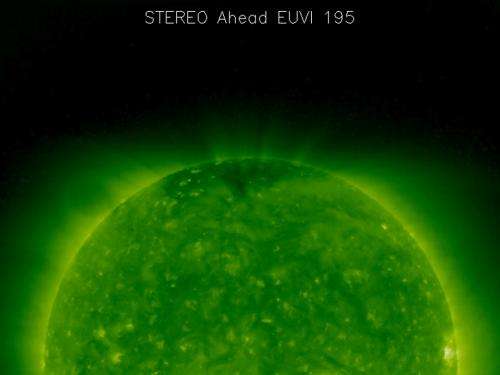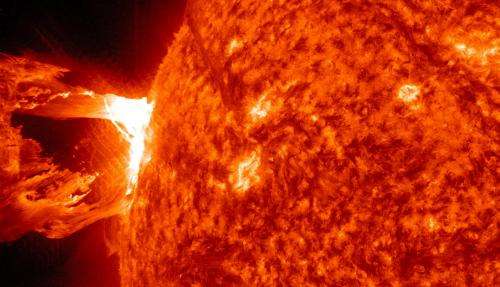Solar fleet peers into coronal cavities

(Phys.org)—The sun's atmosphere dances. Giant columns of solar material – made of gas so hot that many of the electrons have been scorched off the atoms, turning it into a form of magnetized matter we call plasma – leap off the sun's surface, jumping and twisting. Sometimes these prominences of solar material, shoot off, escaping completely into space, other times they fall back down under their own weight.
The prominences are sometimes also the inner structure of a larger formation, appearing from the side almost as the filament inside a large light bulb. The bright structure around and above that light bulb is called a streamer, and the inside "empty" area is called a coronal prominence cavity.
Such structures are but one of many that the roiling magnetic fields and million-degree plasma create in the sun's atmosphere, the corona, but they are an important one as they can be the starting point of what's called a coronal mass ejection, or CME. CMEs are billion-ton clouds of material from the sun's atmosphere that erupt out into the solar system and can interfere with satellites and radio communications near Earth when they head our way.
"We don't really know what gets these CMEs going," says Terry Kucera, a solar scientist at NASA's Goddard Space Flight Center in Greenbelt, Md. "So we want to understand their structure before they even erupt, because then we might have a better clue about why it's erupting and perhaps even get some advance warning on when they will erupt."

Kucera and her colleagues have published a paper in the Sept. 20, 2012, issue of The Astrophysical Journal on the temperatures of the coronal cavities. This is the third in a series of papers—the first discussed cavity geometry and the second its density—collating and analyzing as much data as possible from a cavity that appeared over the upper left horizon of the sun on Aug. 9, 2007 (below). By understanding these three aspects of the cavities, that is the shape, density and temperature, scientists can better understand the space weather that can disrupt technologies near Earth.
The sun's atmosphere dances. Giant columns of solar material – made of gas so hot that many of the electrons have been scorched off the atoms, turning it into a form of magnetized matter we call plasma – leap off the sun's surface, jumping and twisting. Sometimes these prominences of solar material, shoot off, escaping completely into space, other times they fall back down under their own weight.
The prominences are sometimes also the inner structure of a larger formation, appearing from the side almost as the filament inside a large light bulb. The bright structure around and above that light bulb is called a streamer, and the inside "empty" area is called a coronal prominence cavity.
Such structures are but one of many that the roiling magnetic fields and million-degree plasma create in the sun's atmosphere, the corona, but they are an important one as they can be the starting point of what's called a coronal mass ejection, or CME. CMEs are billion-ton clouds of material from the sun's atmosphere that erupt out into the solar system and can interfere with satellites and radio communications near Earth when they head our way.
"We don't really know what gets these CMEs going," says Terry Kucera, a solar scientist at NASA's Goddard Space Flight Center in Greenbelt, Md. "So we want to understand their structure before they even erupt, because then we might have a better clue about why it's erupting and perhaps even get some advance warning on when they will erupt."
Kucera and her colleagues have published a paper in the Sept. 20, 2012, issue of The Astrophysical Journal on the temperatures of the coronal cavities. This is the third in a series of papers—the first discussed cavity geometry and the second its density—collating and analyzing as much data as possible from a cavity that appeared over the upper left horizon of the sun on Aug. 9, 2007 (below). By understanding these three aspects of the cavities, that is the shape, density and temperature, scientists can better understand the space weather that can disrupt technologies near Earth.
Journal information: Astrophysical Journal
Provided by NASA's Goddard Space Flight Center





















